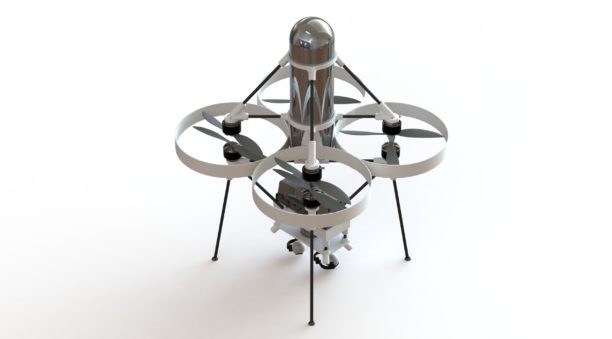
The Jupiter doesn’t look like many of the other drones on display. It’s not a sleek marvel of aerodynamic design like FlightWave’s fixed-wing Edge drone. Nor does it look like any of the other multi-rotors on display at the show. Jupiter was designed with a very specific goal in mind – to provide an endurance drone for indoor (or outdoor in some cases) industrial use.
The hydrogen fuel cell technology that powers Jupiter comes through their partnership with Intelligent Energy. FlightWave CMO Edmund Cronin met the team at Intelligent at an earlier InterDrone conference – and said he knew they were a perfect fit for FlightWave. “Their solution is absolutely unique – we knew they would be great partners to create exactly the drone we wanted,” said Cronin. “I held the fuel cell in my hand and couldn’t believe how lightweight it was. ”
The Jupiter is not the first hydrogen powered commercial drone we’ve seen, but it’s vastly smaller than other offerings, making it appropriate for a wide variety of applications; and it uses a common 3 liter tank for fuel. The tank provides almost 2 hours of flight time. “We used the tank because it’s so easy to source,” said Cronin. “It’s cheap, easy to order, very stable, and incredibly safe.” It’s a more accessible solution, readily available to enterprise customers.
The Jupiter-H2 combines its 2 hour flight endurance with lifting capabilities – up to about 3 pounds of payload. The guarded blades, light weight, narrow profile of 70 cm and quiet operation make it ideal for indoor applications. The drone’s maneuverability means it can navigate a narrow warehouse aisle next to an automatic forklift.
“We view the Jupiter-H2 as a game-changing vehicle,” said Cronin. “It’s particularly well suited to use cases requiring both long flight time and stable manoeuvrability in narrow indoor or outdoor spaces — for example, in a very large but cramped warehouse.”
It’s an elegant idea, and one we haven’t seen before. “The Jupiter-H2’s composite airframe maximizes strength, minimizing structural weight,” says the company. The design allows for simultaneous use of multiple sensors and cameras – and subsystems can draw power directly from the fuel cell. Without the limitation of battery life, this is a significant advantage: it reduces the overall weight of the drone. The universal mount system can accomodate almost any sensor that the customer wants. Refueling is quick and easy.
The Jupiter H-2 may not look like drones we’re used to seeing on the street – but it could be a solution we get used to seeing on the job.
Miriam McNabb is the Editor-in-Chief of DRONELIFE and CEO of JobForDrones, a professional drone services marketplace, and a fascinated observer of the emerging drone industry and the regulatory environment for drones. Miriam has penned over 3,000 articles focused on the commercial drone space and is an international speaker and recognized figure in the industry. Miriam has a degree from the University of Chicago and over 20 years of experience in high tech sales and marketing for new technologies.
For drone industry consulting or writing, Email Miriam.
TWITTER:@spaldingbarker
Subscribe to DroneLife here.
